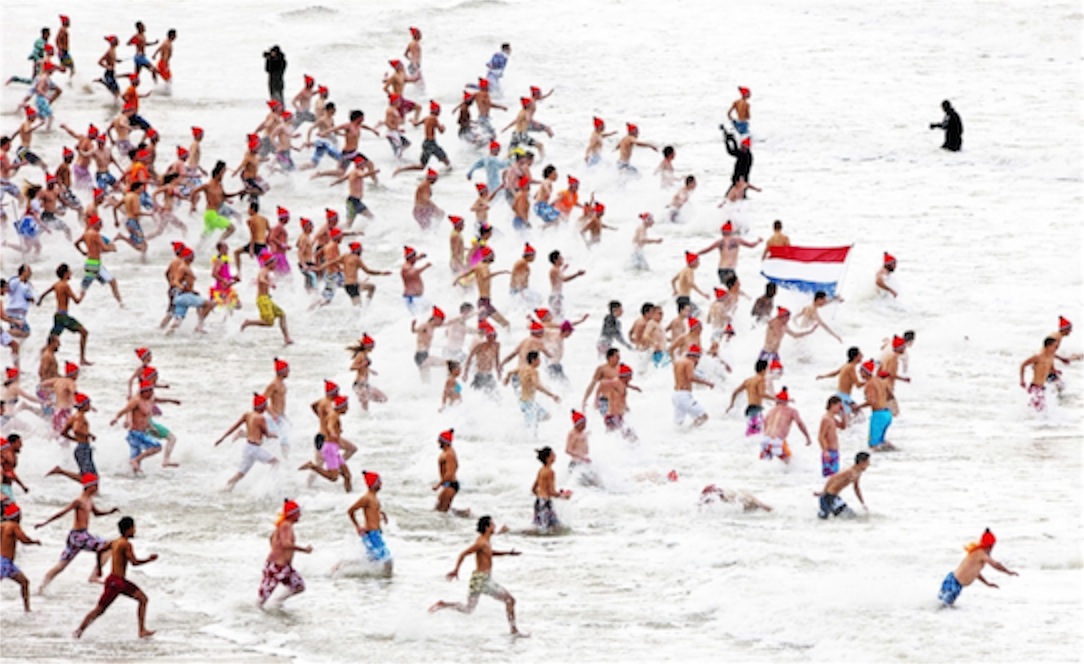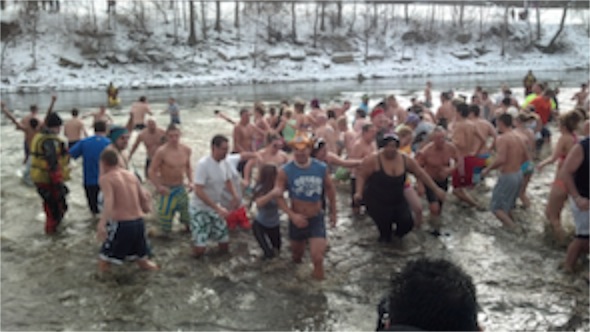New Year's Day Plunge
02/01/13 05:34

I didn’t go swimming yesterday. I did spend about an hour on my rowing machine, exercising and dreaming of better weather when I could get out in a real boat. But there were plenty of swimmers hitting the water in what has become a New Year’s tradition for many.
There were more than 600 swimmers at Jacksonville Beach in Florida, but the weather was hardly “polar.” The water and air were cold enough to feel chilly, though. The water was at 59 degrees and the air in the mid 60’s.
The water was colder – 37 degrees – at the Boulder Reservoir in Colorado as nearly 500 took to the water to raise funds for the Alzheimer’s Association of Colorado.
The numbers were smaller – a few more than 60 – at Lake Merwin in Washington state. They’ve been dipping into cold water in that area since 1971.
The news reports didn’t give a number other than “hundreds” to describe the New Year’s Day plunge at Johnny Appleseed Park in Fort Wayne, Indiana.
In New York, the Coney Island New Year’s Day swim raised funds for relief and recovery from Superstorm Sandy.
Revelers dove into the North Sea in the Netherlands. Swimmers wore fancy dress to participate in the New Year’s Day Looney Duck swim at South Queensferry in Scotland. At Malo-Les-Bains beach in Dunkirk, northern France there was champagne and costumes as people took their New Year’s sea bath. The annual swim in Lake Geneva, Switzerland, featured fancy hats, food and beverages.

I suppose there is something symbolic about plunging into the water as a way of making a fresh start. We use water to cleanse our bodies and to clear our minds. Swimming has long been recognized as a healthful way to keep physically fit. And there is definitely something about plunging into cold water that focuses your attention and gives you a sense of being alive.
There are probably ancient traditions of taking a swim to celebrate a new year, but the popularity of such activities seems to be largely a 20th Century phenomena. The Boston event dates back to 1904. The plunge in Vancouver, British Columbia began in 1920. The big Nieuwjaarsduik in the Netherlands dates back only to 1960. In Finland, folks claim to have been dipping into icy waters for centuries, but the tradition is part of a wider Northern European tradition of becoming super heated in a sauna and then plunging into cold water to rapidly cool afterward.
Winter swimming may contribute to better health, or at least to a sense of well-being. People who suffer from rheumatism, fibromyalgia and asthma have all reported that winter swimming relieves pain. There are claims that it improves memory, raises moods and makes people feel more energetic.
But you have to admit that the idea does sound a bit crazy. Just because it is the most vigorous of people who take the plunge doesn’t mean that their vigor is caused by the dip into the icy water. I didn’t give it a try, so I guess I have no particular expertise. I’ve been known to turn off the hot water in the shower from time to time just to feel the sensation of the cold against my skin. It really wakes me up and reminds me of the luxury that surrounds me every day. But I don’t linger under the cold stream. I’m quickly reaching for the faucet to turn up the temperature or for my towel to dry and get dressed for the day.
What I do know is that there is an eagerness for new beginnings. People want to believe that something new is possible – that they are not stuck in the way things have been. People want to believe that problems can be solved, that they can make a fresh start, and that the way things have been is not the way they will always be. A New Year represents the possibility of a new direction for lives. In the church we use the water of baptism as a symbol for our belief that things can change and that we can make new beginnings. God continues to create and the way things appear now is not the final word on the meaning of life.
The contrast of looking at pictures of New Year’s Day revelers taking the icy plunge and the pictures of legislators in their suits and ties negotiating deals on (or over) the fiscal cliff was striking as I took a look at the news this morning. Although there is some relief that a deal was struck and that some of the worst possible effects of inaction have been temporarily averted, there is very little sense that our elected officials have shown either good judgment or leadership in the past few weeks. There has been far too much grandstanding and game playing for most of us to stomach.

Then, on January first, after having taken the plunge, they could all start over and work on fresh solutions to our shared problems.
Who knows? Polar plunges are often used as fund-raisers and our elected officials seem to be particularly adept at raising funds.
The idea probably won’t catch on, but it’s a thought.